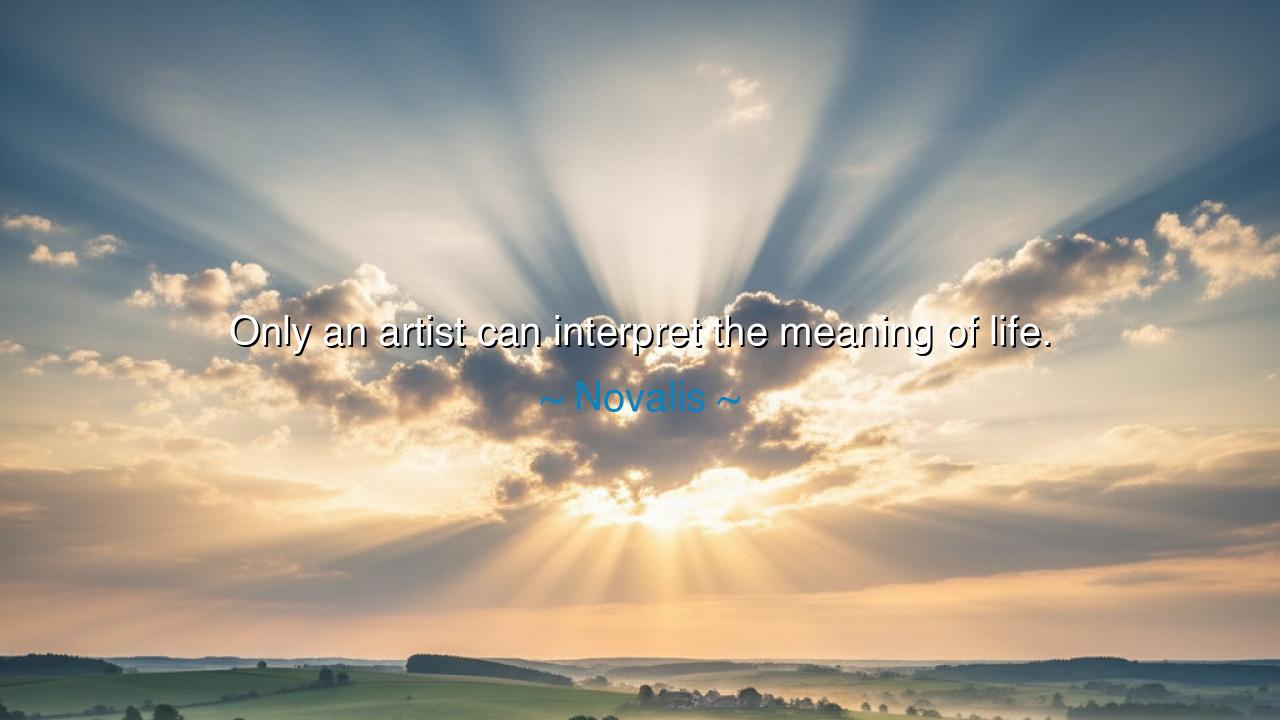
Only an artist can interpret the meaning of life.






When Novalis, the mystic poet of early German Romanticism, wrote, “Only an artist can interpret the meaning of life,” he was not speaking merely of painters, poets, or musicians — he was speaking of the artist within every soul that dares to see the world not only as it is, but as it could be. His words are a hymn to the creative spirit, to that sacred faculty which transforms existence from a chain of days into a tapestry of wonder. For Novalis believed that truth is not discovered by logic alone, but revealed through imagination, that divine spark which gives form to meaning and color to the invisible.
To understand the origin of this quote, one must return to the late eighteenth century, when the Romantic movement was rising against the cold reason of the Enlightenment. The age of machines and measurement had begun to strip the world of its soul; nature was reduced to mechanism, and man to utility. But Novalis — born Friedrich von Hardenberg — rebelled against this desolation. For him, life was not a formula to be solved but a mystery to be interpreted, and the interpreter was the artist, the one who could perceive eternity in the fleeting, the infinite in the finite, and beauty in the ordinary. He wrote of the heart’s vision, of “romanticizing the world” — by which he meant restoring to life its lost holiness.
To say that only an artist can interpret the meaning of life is not to exclude the thinker or the scientist, but to elevate the creative soul that lives in all who see beyond mere facts. The scientist explains the stars, but the artist feels their silence; the philosopher defines love, but the artist gives it voice. It is the artist’s task to make the invisible visible — to paint grief so it may be understood, to sing of joy so it may be shared, to shape the unspoken truths of the human heart into something we can behold and say, “Yes, that is me.” The artist interprets life not by calculation, but by compassion — for to interpret is to feel deeply, and to feel deeply is to live.
Think of Vincent van Gogh, who found beauty where others saw desolation. In his loneliness, he painted wheat fields that glowed like the fire of heaven, and stars that danced in infinite spirals of light. His art was born of pain, yet through that pain he touched the eternal. He was not merely painting fields and skies — he was painting the soul of existence, the silent pulse of life itself. Through his eyes, the world became not a landscape of despair, but a living prayer. In him, Novalis’s words find their perfect embodiment: the artist does not escape life, but interprets its suffering and turns it into meaning.
For the artist’s power lies not in creating something new, but in revealing what was always there — the sacred hidden beneath the ordinary. Where others see chaos, the artist sees pattern; where others despair, the artist sees a story unfolding. In this way, art becomes a mirror through which life recognizes itself. The poet writes of death, and we feel strangely comforted; the musician plays a melody, and we remember something timeless we thought we had forgotten. Thus, the artist becomes the bridge between the finite and the infinite — between man and meaning.
Yet Novalis’s words also whisper a challenge: that we are all called to live as artists. For life itself is an art — the art of seeing with wonder, of shaping our days into beauty. You need not paint or compose to fulfill this calling; it is enough to live creatively, to respond to life not with despair but with imagination. When you face suffering, seek the lesson hidden within it. When you behold joy, let it inspire gratitude rather than greed. To interpret life is to participate in its creation — to be, not a spectator, but a co-artist with the divine.
The lesson of Novalis’s wisdom is clear: do not reduce life to a problem to be solved. Live it as a poem to be read, a song to be sung, a masterpiece in the making. Seek not certainty, but depth; seek not control, but meaning. For the mind may measure existence, but only the heart, awakened by imagination, can interpret it. Cultivate beauty wherever you are — in words, in deeds, in silence. Let your life itself become your canvas, painted with kindness, courage, and wonder.
So remember, as Novalis once taught: the true artist is not merely one who creates art, but one who sees the world as art. When you look upon life with reverence, even sorrow becomes sacred, and even the smallest moment shines with eternity. For in the end, it is not logic that explains the mystery of being — it is the artist’s gaze, that looks upon the world and whispers, “This too is beautiful,” and by that act of love, gives it meaning.






AAdministratorAdministrator
Welcome, honored guests. Please leave a comment, we will respond soon